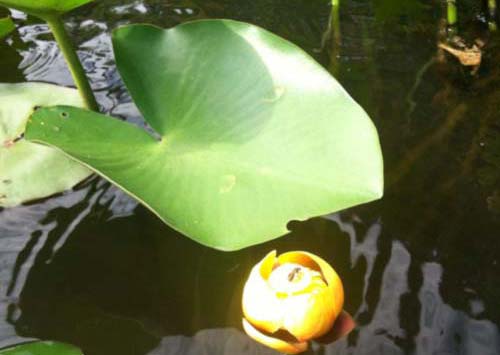Spatterdock
As the spatterdock (Nuphar luteum) plants grow and leaves emerge from the water in summer, they become some of the best spots for flipping on any lake. Pitch a bait at the base of each leaf—this is a very common place for bass to hang out, especially on a sunny summer day when cover is paramount.

Seasonal Techniques
Spring—Spatterdock emerges from underground rhizomes in spring. Leaves will start out resembling lettuce growing on the lake bottom but by late spring will begin to reach the water surface, and the plant's long, heart-shaped leaves will begin to float. In early spring, isolated patches of freshly sprouted spatterdock can be some of the only vegetation actively growing. Fish soft plastics, chatterbaits or a swim jig around these isolated vegetation clumps as shad and other baitfish congregate around the newly formed structure.
Summer—During summer, rapid growth occurs and leaves will begin to appear to rise above the water surface. By mid-summer, the plant will begin to show a yellow ball-shaped flower in which lie the plant's seeds. As the plants grow and leaves emerge from the water, they become some of the best spots for flipping on any lake. Pitch a bait at the base of each leaf, toward the large palm-like stems. This is a very common place for bass to hang out, especially on a sunny summer day when cover is paramount.
Fall—In fall, the plant will drop it’s seeds and begin to die back in response to colder weather. The leftover stalks and root systems of spatterdock make excellent woodlike structures over which to drop a jig or Texas rigged worm.
Winter—Spatterdock will overwinter as a rhizome and resprout in the spring either from the rhizome or from seed. The leafy portions of spatterdock will be non-existent in winter. However some of the root system and plant bases may stay around all winter. These spots make for great fishing with a swim jig or chatterbait.
Habitat Value
Fish—The submersed portions of spatterdock make for excellent invertebrate habitat while also providing refuge for baitfish and juvenile bass. The large almost tree-trunk like stems of spatterdock make excellent spots for predatory species like bass.
Waterfowl—The seeds produced by spatterdock are readily consumed by waterfowl.
Identifying Features
What It Looks Like—Spatterdock is easily identified by its long, notched leaves and seemingly “petal-less” yellow flower, which resembles a tennis ball. The large, spongy root system is also characteristic of spatterdock.
Where to Find It—You can find spatterdock in many near-shore areas where nutrients are readily available.
Max Depth—0 to 5 feet
Similar Species—Spatterdock can sometimes resemble other floating leaved plants, like water-lily; however water-lily has a distinct pie-shaped cut in the round leaf and often has a white or pink flower, whereas spatterdock has a much less pronounced notch and yellow flowers.
Drawbacks
Spatterdock can sometimes cause water-use issues—especially for boating and swimming. It sometimes requires management. Cost to manage: $$ of $$$$$.
Contact Us
We're always looking for more information about aquatic plants on TVA reservoirs. Let us know where and what you see, and send us your photos. Email us.